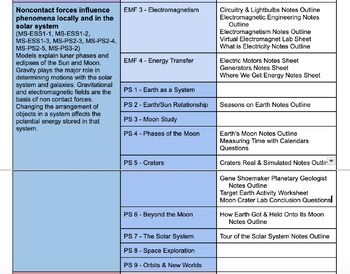FOSS Planetary Science Graphic Organizers
Sarah DeMatteo
1 Follower
Grade Levels
8th
Subjects
Resource Type
Standards
NGSSMS-ESS2-2
NGSSMS-PS2-4
NGSSMS-ESS1-2
NGSSMS-ESS1-3
NGSSMS-ESS1-1
Formats Included
- Zip
Sarah DeMatteo
1 Follower
Description
These outlines and lab sheets are meant to pair with the FOSS Planetary Science Unit. They go along with the readings, slides, and activities listed in the FOSS curriculum. Sheets can be printed or assigned digitally. Zip file of 11 docx files.
Total Pages
Answer Key
N/A
Teaching Duration
N/A
Report this resource to TPT
Reported resources will be reviewed by our team. Report this resource to let us know if this resource violates TPT’s content guidelines.
Standards
to see state-specific standards (only available in the US).
NGSSMS-ESS2-2
Construct an explanation based on evidence for how geoscience processes have changed Earth’s surface at varying time and spatial scales. Emphasis is on how processes change Earth’s surface at time and spatial scales that can be large (such as slow plate motions or the uplift of large mountain ranges) or small (such as rapid landslides or microscopic geochemical reactions), and how many geoscience processes (such as earthquakes, volcanoes, and meteor impacts) usually behave gradually but are punctuated by catastrophic events. Examples of geoscience processes include surface weathering and deposition by the movements of water, ice, and wind. Emphasis is on geoscience processes that shape local geographic features, where appropriate.
NGSSMS-PS2-4
Construct and present arguments using evidence to support the claim that gravitational interactions are attractive and depend on the masses of interacting objects. Examples of evidence for arguments could include data generated from simulations or digital tools; and charts displaying mass, strength of interaction, distance from the Sun, and orbital periods of objects within the solar system. Assessment does not include Newton’s Law of Gravitation or Kepler’s Laws.
NGSSMS-ESS1-2
Develop and use a model to describe the role of gravity in the motions within galaxies and the solar system. Emphasis for the model is on gravity as the force that holds together the solar system and Milky Way galaxy and controls orbital motions within them. Examples of models can be physical (such as the analogy of distance along a football field or computer visualizations of elliptical orbits) or conceptual (such as mathematical proportions relative to the size of familiar objects such as students’ school or state). Assessment does not include Kepler’s Laws of orbital motion or the apparent retrograde motion of the planets as viewed from Earth.
NGSSMS-ESS1-3
Analyze and interpret data to determine scale properties of objects in the solar system. Emphasis is on the analysis of data from Earth-based instruments, space-based telescopes, and spacecraft to determine similarities and differences among solar system objects. Examples of scale properties include the sizes of an object’s layers (such as crust and atmosphere), surface features (such as volcanoes), and orbital radius. Examples of data include statistical information, drawings and photographs, and models. Assessment does not include recalling facts about properties of the planets and other solar system bodies.
NGSSMS-ESS1-1
Develop and use a model of the Earth-sun-moon system to describe the cyclic patterns of lunar phases, eclipses of the sun and moon, and seasons. Examples of models can be physical, graphical, or conceptual.


